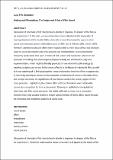Files in this item
Feeling and filmmaking : the design and affect of film sound
Item metadata
| dc.contributor.author | Donaldson, Lucy Fife | |
| dc.date.accessioned | 2017-03-06T17:30:08Z | |
| dc.date.available | 2017-03-06T17:30:08Z | |
| dc.date.issued | 2017-03 | |
| dc.identifier | 247757394 | |
| dc.identifier | bf53ced0-2498-4f29-ac64-c3cbdb3b6912 | |
| dc.identifier | 000406050900003 | |
| dc.identifier.citation | Donaldson , L F 2017 , ' Feeling and filmmaking : the design and affect of film sound ' , The New Soundtrack , vol. 7 , no. 1 , pp. 31-46 . https://doi.org/10.3366/sound.2017.0095 | en |
| dc.identifier.issn | 2042-8855 | |
| dc.identifier.other | ORCID: /0000-0002-4029-7465/work/61978877 | |
| dc.identifier.uri | https://hdl.handle.net/10023/10408 | |
| dc.description.abstract | Discussion of cinematic affect most typically attends to response, the impact of the film as we experience it. In this vein, various writers have drawn attention to the physicality of hearing (Sobchack 2005; Cubitt 1998), while others have illuminated the ways in which sound communicates sensory information about the film world (Altman 1992; Chion 1994). However, attention to practice offers further opportunities to think about affect, that decisions made by sound practitioners take into account such considerations; sound practitioners frequently speak about their work in terms of feel, texture and experience. Moreover, the processes of creating film sound requires physical activity and involvement, play and experimentation, which might be literally physical, or have a kind of tactile analogy (to weaving, sculpting and so on). In this sense, affect is in the labour of making the film, as well as in our watching of it. Bringing together theory and practice therefore offers an opportunity to more fully develop an account of the particular contributions of sound to cinematic affect, and perhaps illuminate the significance of practitioners work to the sensory appeal of film more generally – highlighting the creative effort of those filmmakers who traditionally receive less recognition for their achievements. Drawing on published and unpublished interviews with film sound personnel, this article will seek to show how a connection between theory and practice enables a deeper comprehension of filmic affect, traced through the embodied and empathetic qualities of sound work. | |
| dc.format.extent | 323299 | |
| dc.language.iso | eng | |
| dc.relation.ispartof | The New Soundtrack | en |
| dc.subject | Sound design | en |
| dc.subject | Affect | en |
| dc.subject | Embodiment | en |
| dc.subject | Materiality | en |
| dc.subject | Sensory cinema | en |
| dc.subject | Sound practice | en |
| dc.subject | PN1993 Motion Pictures | en |
| dc.subject | T-NDAS | en |
| dc.subject | BDC | en |
| dc.subject | R2C | en |
| dc.subject.lcc | PN1993 | en |
| dc.title | Feeling and filmmaking : the design and affect of film sound | en |
| dc.type | Journal article | en |
| dc.contributor.institution | University of St Andrews. Film Studies | en |
| dc.contributor.institution | University of St Andrews. Centre for Ancient Environmental Studies | en |
| dc.identifier.doi | https://doi.org/10.3366/sound.2017.0095 | |
| dc.description.status | Peer reviewed | en |
| dc.date.embargoedUntil | 2017-02-23 |
This item appears in the following Collection(s)
Items in the St Andrews Research Repository are protected by copyright, with all rights reserved, unless otherwise indicated.

